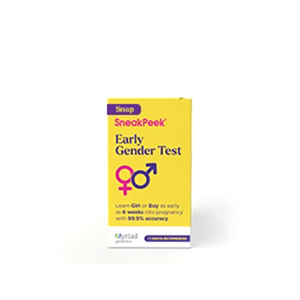Published on January 22nd, 2021 and Updated on January 12th, 2024
Check out SneakPeek Gender Test to find out your baby’s gender as early as 6 weeks at over 99% accuracy1!
Your nighttime routine with your child is precious. You may give her a soothing lavender-scented bath before drying her off and tucking her in. You might sing a lullaby that you loved when you were growing up. You might even give your baby a little massage to help her melt into sleepiness. When her little eyelids begin to droop, you know your bedtime routine has done its magic.
The time between that last good night kiss and your child’s arrival to dreamland is more than just a win for mom or dad—it’s sleep latency.
What is sleep latency?
Sleep latency (or sleep onset) is the time it takes to go from being fully awake to fully asleep, and it can vary from person to person.
Your child may tend to drift off before you finish the final verse of a lullaby. Or perhaps he gets quite high on the sheep count before falling asleep. In any case, understanding your child’s sleep latency can help you support healthy sleep habits and mind-body-wellness for your little snoozer.
Normal, Actual, and Ideal: Understanding the Nuances of Sleep Latency (H2)
Understanding what sleep latency is right for your child starts with understanding the kinds of sleep latency there are. Here are a few terms to know:
- Normal sleep latency – Normal sleep latency is the amount of time it takes a typical person of a certain age to fall asleep. For children, normal sleep onset is 12-20 minutes.
- Actual sleep latency – Actual sleep latency is simply how long your child takes to fall asleep on a given night. Parents know that some days, children drop into rem sleep like rocks. Other nights they toss and turn for what feels like hours before the Sand Man arrives.
- Ideal sleep latency – This is the sleep latency that’s right for your individual child. Genetics is what drives your child’s ideal sleep latency. For some children, ideal sleep latency is in the “normal” range for their age. Others may have longer or shorter sleep latencies than normal, as determined by their genetics.
What You Can Learn From Your Child’s Sleep and Sleepiness
While 12-20 minutes is the normal sleep latency for children, your little Goldilocks may experience shorter or longer sleep latencies, and that might just be how she’s genetically inclined. However, if you see any of the below issues, it could be cause for concern:
- A short actual sleep latency of less than five minutes might indicate your child is suffering from sleep debt. That means that even though she falls asleep quickly, she may toss and turn throughout the night and show signs of excessive daytime sleepiness or crankiness. If you see this, try putting her to bed 15 minutes earlier every couple of nights until she seems more awake and alert in the mornings. If her short actual sleep latency persists and if she seems drowsy consistently in the mornings, your pediatrician or a sleep specialist may be able to provide guidance on next steps.
- A longer actual sleep latency of 30 minutes or more could be signs your child needs more support getting to sleep. There could be many reasons your little snoozer has a hard time drifting off, including:
- Uncomfortable sleep environment – As most grown-ups know, comfort is king when it comes to falling asleep. If your child doesn’t feel at ease in her crib or bed, it might take her a while to settle down to slumber. Multiple factors can affect a child’s comfort level, from the temperature of the room to itchy new sheets on her sensitive skin. Even the smell of a new detergent might be uncomfortable enough to postpone her arrival to Snoozeville! Take a look at your child’s sleep environment and see if you can identify a potential sleep disturbance. That way you can make it as cozy and comfy as possible.
- Too much light in the room – Light sends “wake-up” signals to your child’s brain, which can extend her sleep latency and cause sleep deprivation. Check the sources of light in your child’s room around her bedtime. Maybe a neighbor’s motion-activated porch light shines into the room or a streetlamp outside the window is too bright for your child’s eyes to close. Try putting up some curtains to make sure the scene is set for sleep.
- Your child’s chronotype— If your child is taking a while to fall asleep, her internal clock might be set to a later bedtime thanks to her genetic chronotype. A chronotype is the body’s predisposition for either late nights or early mornings. If your child stays awake long after you put her to sleep, she might have a night owl chronotype. In that case, her bedtime is just a bit too early for her body’s inner clock to realize it’s time to sleep.
If your child is bright-eyed and rested despite sleep latencies that are shorter or longer than “normal,” genetics may be at play and her ideal sleep latency might just fall on the shorter or longer side, and not be an indication of sleep problems, meaning no cause for concern.
If you are concerned your baby is having sleep problems, or you’ve noticed excessive daytime sleepiness, consider keeping a sleep diary to help you identify what patterns work best for your little one. If you’re curious as to what your child’s sleep patterns might look like, consider trying our sleep DNA test. The test results will help you get a better understanding of your child’s sleep so you can create healthy habits that nurture his or her individual sleep profile.
Why is sleep latency important?
Discovering your child’s ideal sleep latency might be the key to unlocking your child’s best sleep. Sleep latency can affect key factors of your child’s overall sleep health including:
Sleep Quality
Understanding your child’s sleep latency may be the key to avoiding sleep deprivation. Normal sleep latencies have been connected to improved sleep quality in children. Researchers theorized that when children fall asleep within the normal range of sleep latency, sleep cycles can begin faster, thus maximizing the time spent in rem sleep for maximum health benefits.
Sleep Latency and Health
Scientists have confirmed the relationship between high quality sleep and sleep latency. And that deep, nourishing sleep can help support your child’s health in a number of ways including:
- Immune System – Sleep and immune system health are bidirectionally linked, meaning they work as a team to keep your child well. So when your child is sleeping well, that can lead to:
- Reduced infection risk
- Improvement in how your child’s body handles viruses like the common cold
- Maintains your child’s antibody levels—these are the cells that fight viral intruders
- Growth and Development – Sometimes, it can feel like your child grows overnight. In fact, deep sleep triggers the body to release an assortment of growth hormones. These hormones also help your child accumulate muscle mass, repair cells and tissues, and even cement new memories in your child’s brain.
- Mental Wellness – A sleep study published in The Journal of Sleep Research found that children with a normal sleep latency had notably higher self-esteem, a more positive outlook on their day, and even improved social skills. These correlations remained across children’s age, sex, BMI, and even their parents’ levels of education!
What affects sleep latency?
Reaching an ideal sleep latency can lead to improved health from your child’s head to her tiny toes. But what exactly affects sleep latency? It comes down to two main factors: environment and genetics.
Environment
Think about your ideal sleep environment. You probably like the lights off, silence or a white noise machine murmuring in the background, and comfy sheets and pillows to snuggle into at the end of a long day.
Chances are, your child may need the same things. So when considering how to support your child’s ideal sleep onset latency, take a look at the following elements that can help (or hinder) a proper transition to sleep.
- Sound – Sounds can trigger your child’s Moro reflex, or her startle reflex. The Moro reflex is kind of like the brain’s alarm system. When there are noises nearby, the Moro reflex keeps your child’s brain on high alert in case of a threat—not the best mindset to be in for sleep After your child’s evening lullaby, try to keep her bedroom quiet. Or, try putting on a white noise machine to encourage her mind to relax and drift off.
- Light Exposure – When our bodies are exposed to light, receptors in our eyes tell our brains to stay awake by preventing the production of melatonin, the sleep hormone. When the lights are off, your brain gets the picture that it’s time to get some z’s.
- Temperature – If your child’s sleep area is too warm, it may be difficult for her body to feel comfortable enough to fall asleep. In fact, the Sleep Foundation states that the ideal bedroom temperature for sleep is 65 degrees. Being too warm also prevents the body from making—you guessed it—melatonin.
Scientists attribute this to our circadian rhythm, the body’s inner clock. The circadian rhythm uses light and heat cues to learn when it’s daytime and when it’s nighttime. So the brighter (and warmer) it is, the more difficult it will be to fall asleep.
Make sure your child is nice and snuggly in cozy sleepwear and keep the thermostat down low so she can snooze to her heart’s content.
Genetics
Some things, like your child’s ear lobes and his nose, can be traced back to genetics. And while environmental factors can make a big impact on a child’s ideal sleep latency, genetics plays a role as well.
A sleep study published in 2016 examined over 4,000 individuals found that a variant in the RBFOX3 gene contributed to a person’s sleep ideal latency. The RBFOX3 gene primarily works to support the health and development of the brain, the body’s headquarters for sleep management. The RBFOX3 gene also contributes to:
- Key functions of the central nervous system like sleep latency and sleep cycles
- Development of neural tissue
- Production of key brain cells
Since sleep is a mind-body experience, it makes sense that a gene that works primarily in our brains has such a big impact on sleep latency.
Your child’s ideal sleep latency can reveal a whole new world of incredible sleep and wellness for your child. Understanding your child’s ideal sleep latency can help you build the most beneficial sleep plan for him so the whole family can avoid sleep deprivation and get a better night’s sleep.
This post has been reviewed for accuracy by the following medical professional:
Katie Smith is a seasoned Certified Nurse Midwife and a nurturing mother to six children, offering a unique blend of professional expertise and personal experience. She is the founder of Birth Your Way Midwifery and Women’s Wellness Center in Bay County, Florida. Katie's comprehensive approach to care is informed by her hands-on experience in motherhood and her passion for empowering women through their birthing journey. Her dedication extends beyond her center as she actively engages in community wellness and family health education.
Sources:
- US National Library of Medicine. Sleep physiology and sleep disorders in childhood.https://www.ncbi.nlm.nih.gov/pmc/articles/PMC3630965/
- US National Library of Medicine. Sleep quantity, quality and optimism in children. https://www.ncbi.nlm.nih.gov/pmc/articles/PMC4160149/
- US National Library of Medicine. The Sleep-Immune Crosstalk. https://pubmed.ncbi.nlm.nih.gov/30920354/
- Center for Disease Control and Prevention. Sleep and the Immune System. https://www.cdc.gov/niosh/work-hour-training-for-nurses/longhours/mod2/05.html
- Sleep Foundation. The Best Temperature for Sleep. https://www.sleepfoundation.org/bedroom-environment/best-temperature-for-sleep#:~:text=The%20best%20bedroom%20temperature%20for,for%20the%20most%20comfortable%20sleep.

Shop Our Products
SneakPeek aims to provide the most accurate and up-to-date information to help our readers make informed decisions regarding their health before, during, and after pregnancy. This article was written based upon trusted scientific research studies and/or articles. Credible information sources for this article are cited and hyperlinked.






